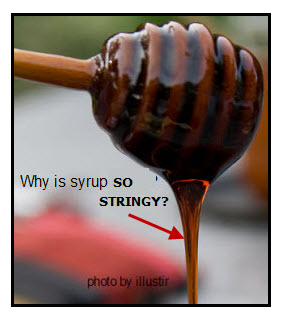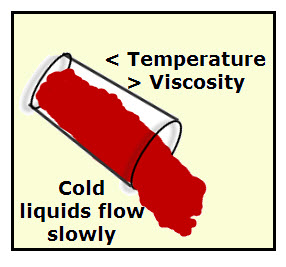Question: Why does “snow” in snow globes fall slowly? Answer: The “snow” can be plastic glitter or some even use finely ground egg shells. What ever is used for snow, it must be able to fall through the fluid that fills the jar (the globe). Fluid is a term used for a gas or a […]
Cohesion: Attraction Between Like Molecules
Cohesion is the attractive force between like molecules, such as between two water molecules or between two syrup molecules. The syrup in the photo forms a single cascading stream because the syrup molecules are attracted to each other. Discover Cohesion Yourself Wet your thumb and forefinger with water. Press these two fingers together, and then […]
Viscosity
LIQUIDS FLOW Because liquid particles can move past each other, they can flow. This is very important when transporting liquids from one place to another through pipes or water ways. VISCOSITY is a measure of the resistance of a liquid to flowing. The viscosity of a liquid increases as the temperature of a liquid decreases. […]
Polymer: Slime Facts
Elmers glue and other comparable school glues are polyvinyl adhesive (PVA). Slime is made by mixing PVA glue with a solution of borax. Slime is a polymer, which is a chemical consisting of large molecules made of a linked series of repeating units called monomers. The polymer slime produced is not as runny as the PVA glue […]
Snow Globes
I love snow globes. Have you ever wondered what makes the glittery stuff inside the globe drift down slowly? It really does look like falling snow? 1.One factor is the viscosity (thickness) of the liquid. Viscosity is a fancy scientific name for describing the resistance of a fluid (gas or liquid) to flow. It could […]



